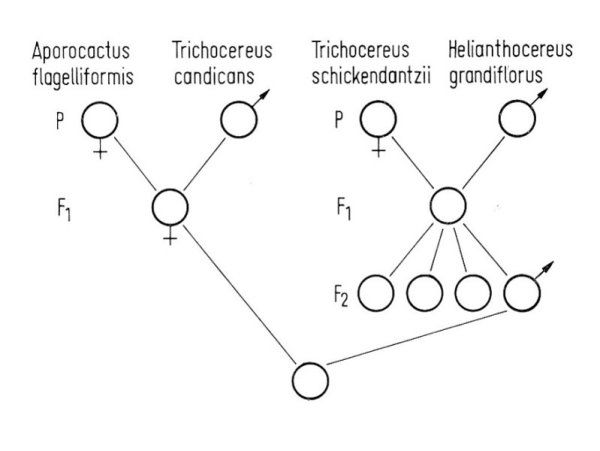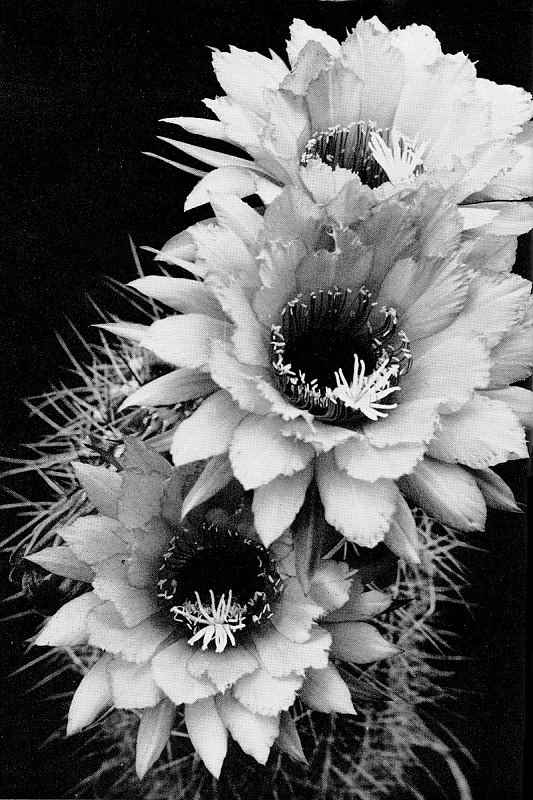Unfortunately, the glorious blossom here can only be shown in black and white. The diameter of the blossom is 15 cm. The colour can be denoted as old rose. The blossom leaves are fringed and edged in a crimson colour. In summer 1966 the plant produced 6 blossoms. Four types which belonged to 3 species were included in the creation of this hybrid, displayed by the enclosed abstract.

Pic.1 Cross-breeding scheme of the described hybrid.
The female parent of the hybrid, itself already a hybrid, was created by the
F1
from the cross-breeding Aporocactus flagelliformis x Trichocereus candicans.
I have already reported about this strange cross-breeding and its breeding in the magazine
(KuaS 1957, 130, 'Two beautiful hybrids').
Concerning the hybrid male parent, I have to explain in more detail. Firstly I cross-bred the white-blooming Trichocereus schickendantzii with the red blooming Helianthocereus grandiflorus. The latter type was earlier widely known in the collection by the name Lobivia grandiflora; it was named by
BRITTON und ROSE.
This kind is surely no Lobivia; rather, it is closer to Trichocereus schickendantzii and can be considered in my opinion as a day blooming Trichocereus. But
Backeberg
defined it as a new species: Helianthocereus and Lobivia grandiflorus was renamed AS Helianthocereus grandiflorus. The F1 was
intermediary
in its appearance, the blossom light red in colour. The F1 bastard was self-sterile as were his parents already. Two F1 plants were thus necessary to pollinate successfulLY to produce the F2. The body differences were slight in the F2. In the blossom colour, which I inten-
ded clear separation occurred. Regarding the white of the Trichocereus schickendantzii, via lighter and darker tones to the even stronger and darker red than that of the Hel. grandiflorus, everything was present. From this F2 I chose the plant with the most beautiful, darkest blossom as the male parent.
The result of the cross-breeding was then an offspring in which the predisposition of the four initial types have been combined in various ways which lead in the concurrence to blossoms with new attributes. The bodies all remind one of Trichocereus candicans. Remarkable is the big stipe diameter of the hybrid, exactly 20 cm. They have the smaller stalk diameters of the initial types: A. flagelliformis 1,2 cm, T. candicans 13 cm, T. schickendantzii 6cm, Hel. grandiflorus
5cm. Among the seedlings so far bred to bloomability, two were distinguished by particular beauty and character of the blossom and have been selected. Below, this plant is described and displayed
(connotation: 'Gräsers Schönste')
along with a second one, slightly smaller, with strikingly dark crimson coloured blossoms and also fringed and darker-rimmed blossom leaves (connotation: 'Gräsers Erfolg'.)

Pic.2 'Gräsers Schönste', (Aporoc. flagelliformis x Tr. candicans) X (Tr. schickendantzii x Tr. grandiflorus SCHIGRA F2 dark red).
This Robert Gräser article 'A Beautifully Blooming Hybrid', was published in 1967(1) in the
'KuaS.'
Publication of the Article with kind permission of the editorial office of the KuaS.

´Eine schönblühende Hybride´
made by ´Horsti´, Horst Osterwald.

